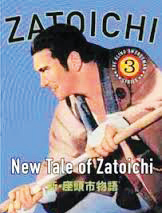 I am not a woman naturally drawn to serenity or stillness. I am often tangled in the trees and quite unable to detect the shape of the forest. I do not tend to meditate, or exercise with the kind of disciplined regularity required to make up a healthy habit. There is however, a place I can go to escape the world and myself. It’s on video and it’s available in abundance of YouTube.
I am not a woman naturally drawn to serenity or stillness. I am often tangled in the trees and quite unable to detect the shape of the forest. I do not tend to meditate, or exercise with the kind of disciplined regularity required to make up a healthy habit. There is however, a place I can go to escape the world and myself. It’s on video and it’s available in abundance of YouTube.
At night, in bed, before I fall asleep, I watch a story about a humble, blind masseur wandering through Edo period Japan: my own personal Jesus—Zatoichi, (Masseur Ichi). Of course he is, as someone points out at least once an episode “no ordinary masseur”…. His adorable, bumbling demeanor conceals his deadly, almost miraculous swordsmanship. The sword is faster than the eye is the series’ tagline, and you can look as close as you like but all you will see is Zato, not drawing, but sheathing, his commoner’s cane sword. All you hear is the metallic swish-clunk as sword returns to scabbard. Then, several feet away, a sake cup splits slowly in two, or a wingless fly lands in the dinner of an arrogant Yakuza boss. To me, this is a vacation.
 Katsu Shintaro — the actor who brought Zato to beloved life in a series of Jidai-Gekki (period films, like our Westerns) — was a workaholic even by his country’s manic standards. Between 1963 and 1974 he starred in three movie serials, of which Zatoichi was only the most popular and then, in the 70’s, produced and starred in the Zato TV series; four seasons and 100 episodes, each made with the care and flavor of an auteur driven film.
Katsu Shintaro — the actor who brought Zato to beloved life in a series of Jidai-Gekki (period films, like our Westerns) — was a workaholic even by his country’s manic standards. Between 1963 and 1974 he starred in three movie serials, of which Zatoichi was only the most popular and then, in the 70’s, produced and starred in the Zato TV series; four seasons and 100 episodes, each made with the care and flavor of an auteur driven film.
Great and intellectual cinema, however, this is not. In fact it’s incredibly formulaic; take a poor peasant father hamstrung by outrageously evil Yakusa bosses, a virtuous daughter about to be sold into whoredom, a wandering Ronin assassin, tragic and doomed, and Zato, who would rather just eat, sing and dance if people would only stop doing so much evil. Mix and match, and you have the recipe for any and every Zato tale. But it is just that formula that appeals and soothes.
Then, of course, there is Zatoichi himself; shambling, bumbling, but haunted. He has terrible table manners and a guilty conscience. He attracts children and dogs and he can’t control his paternal impulses around young women. Bowlegged, his head wrapped in a burlap kerchief, he has inspired more than one Western characterization, the most famous of which is Peter Falk’s “Columbo”. But this — as interesting as it might be to those who find that sort of thing interesting — is not what makes the tales of Zatoichi my retreat. What draws me in is the idea of a well told tale as a place to go.
 For 49 minutes every night, I know what’s going to happen. The question is how? And what I watch, and what I delight in, is not narrative —though the tales are sweet — but choreography, set decoration, lighting, the superb slapstick skills of Katsu, who grew up in the theatre, an old hand. The fight scenes are like ballet; bodies moving through space in constant motion, never colliding. I get two kinds of pleasure from these displays — the child’s delight in the story, and the adult’s pleasure in the first rate craftsmanship and artifice.
For 49 minutes every night, I know what’s going to happen. The question is how? And what I watch, and what I delight in, is not narrative —though the tales are sweet — but choreography, set decoration, lighting, the superb slapstick skills of Katsu, who grew up in the theatre, an old hand. The fight scenes are like ballet; bodies moving through space in constant motion, never colliding. I get two kinds of pleasure from these displays — the child’s delight in the story, and the adult’s pleasure in the first rate craftsmanship and artifice.
I do not go to Zatoichi Monongatari (tales of Zato) expecting a challenging narrative. What I’m looking for is a lullaby. A song that sounds just different enough every time it is sung. My time with Zatoichi is an unexpectedly precious ritual. When the opening credits roll and the wanderer appears down the earthen road through the millet fields, I feel like I’m simultaneously on vacation and at home.
Emily Roiphe Carter is a freelance writer for The Phoenix Spirit.
Last Updated on July 23, 2015




